#Lionel Belmore
Explore tagged Tumblr posts
Text

Stan Laurel, Oliver Hardy and Lionel Belmore in a deleted scene from Bonnie Scotland (1935)
#Stan Laurel#Oliver Hardy#Lionel Belmore#Laurel and Hardy#Bonnie Scotland#1935#1930s#features#movies
12 notes
·
View notes
Text
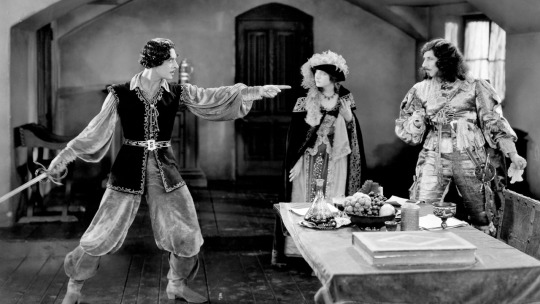
John Gilbert, Eleanor Boardman, and Roy D'Arcy in Bardelys the Magnificent (King Vidor, 1926)
Cast: John Gilbert, Eleanor Boardman, Roy D'Arcy, Lionel Belmore, Emily Fitzroy, George K. Arthur, Arthur Lubin, Theodore von Eltz. Screenplay: Dorothy Farnum, Marian Ainslee (titles), based on a novel by Rafael Sabatini. Cinematography: William H. Daniels. Art direction: James Basevi, Richard Day, Cedric Gibbons.
This entertaining swashbuckler was long thought to be lost, apparently because of a contractual agreement between MGM and Rafael Sabatini, author of the novel on which it was based. When the studio failed to renew the rights to the novel in 1936, it destroyed the negative and all the prints it could get its hands on. Fortunately, 70 years later a print surfaced in France, missing only one reel that the restorers pieced together with production stills and footage from the original trailer. It was a good save, especially for the legacy of its director, King Vidor, and its star, John Gilbert. Vidor stages several lively swordfights and a memorable love scene in which Bardelys (Gilbert) woos Roxalanne de Lavedan (Eleanor Boardman) in a boat as it passes through the overhanging branches of a willow tree. But the film's highlight is a spectacular escape from the gallows, in which Gilbert (almost certainly with the help of his stunt double) outdoes Douglas Fairbanks in swinging from ropes and curtains, climbing walls, and fencing with pursuers. The story is romantic nonsense in which Bardelys, a womanizing marquis at the court of Louis XIII (Arthur Lubin) makes a wager that he can win the hand of Roxalanne, who has spurned the advances of the very hissable villain, Châtellerault (Roy D'Arcy). To win the bet, Bardelys finds himself assuming the identity of a man he finds dead, Lesperon (played by Theodore von Eltz in the missing reel), an enemy of the king. Sure enough, he and Roxalanne fall in love under the willows, but his imposture not only turns her against him when she finds proof that Lesperon is engaged to someone else, but also puts him in danger of being hanged for treason, especially after Châtellerault turns up and refuses to disclose that Lesperon is really Bardelys. Dorothy Farnum adapted the novel, and the cinematography is by William H. Daniels. The cast supposedly includes the 19-year-old John Wayne as a guard, in only his second film appearance, but good luck spotting him.
5 notes
·
View notes
Photo
Frankenstein (James Whale, 1931)
Cast: Colin Clive, Mae Clarke, John Boles, Boris Karloff, Frederick Kerr, Dwight Frye, Edward Van Sloan, Lionel Belmore, Marilyn Harris. Screenplay: Garrett Fort, Francis Edward Faragoh, based on a story treatment by John L. Balderston of a play by Peggy Webling adapted from a novel by Mary Shelley. Cinematography: Arthur Edeson. Art direction: Charles D. Hall. Film editing: Clarence Kolster. Music: Bernhard Kaun.





Elizabeth’s wedding dress in Frankenstein (1931) Costume design by Vera West
3K notes
·
View notes
Text

#ProyeccionDeVida
🎥🎼 La Música en el Cine, presenta:
🎬 “EL DESFILE DEL AMOR” [The Love Parade]
🔎 Género: Comedia / Romance / Musical
⌛️ Duración: 107 minutos
✍️ Guión: Guy Bolton y Ernest Vajda
📘 Obra: Jules Chancel y Leon Xanrof
🎶 Música: W. Franke Harling, John Leipold, Oscar Potoker y Max Terr
📷 Fotografía: Victor Milner (B&W)
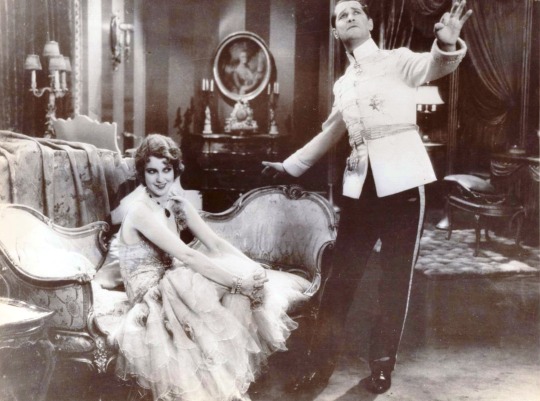
🗯 Argumento: Por sus deshonrosas aventuras en París, el agregado militar, conde Alfred Renard, es devuelto a su país de origen Sylvania, justo en los días en que los miembros del Consejo de Estado andan preocupados porque la reina Louise I no consigue casarse con ninguno de sus pretendientes... pero al ser llevado ante su presencia a la espera de recibir su castigo, Renard conseguirá seducirla y Sylvania va a tener a un príncipe consorte que ha jurado ante la iglesia ser dócil y obediente.
👥 Reparto: Maurice Chevalier (Alfred Renard), Jeanette MacDonald (Queen Louise), Lillian Roth (Lulu), Eugene Pallette (Minister of War), Virginia Bruce, Jean Harlow (Woman in Opera Box), Ben Turpin (Valletto Strabico), Lionel Belmore (Prime Minister), E. H. Calvert (Sylvanian Ambassador) y Edgar Norton (Master of Ceremonies) y Winter Hall.

📢 Dirección: Ernst Lubitsch
© Productora: Paramount Pictures
🌏 País: Estados Unidos
📅 Año: 1929
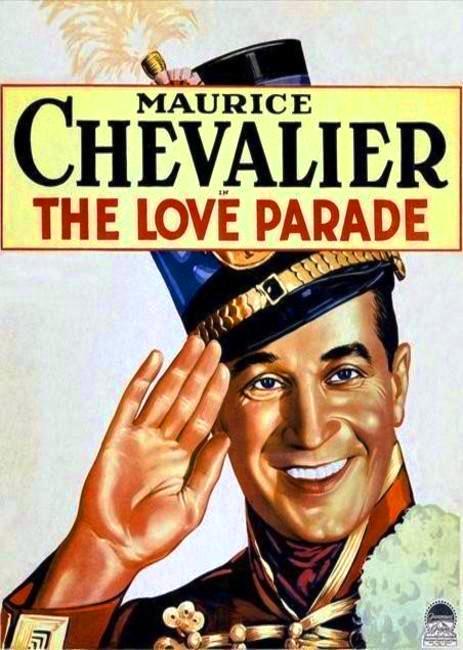
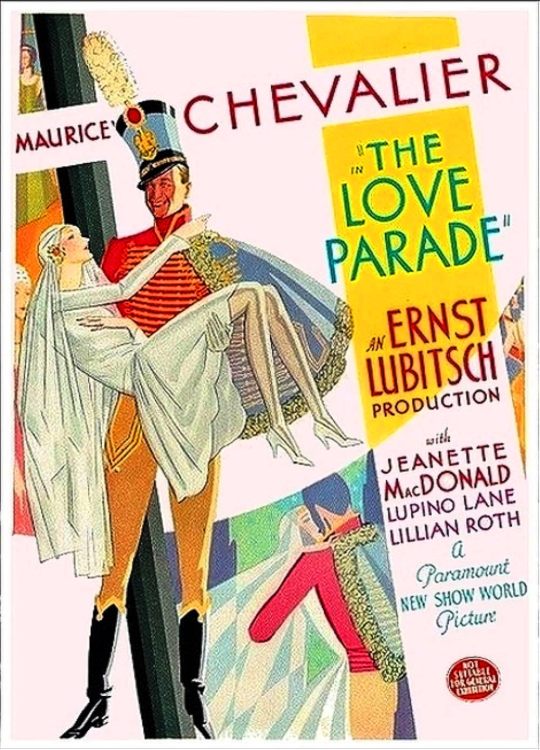
📽 Proyección:
📆 Sábado 23 de Marzo
🕚 11:00am.
🏪 Sala Azul del Centro Cultural PUCP (av. Camino Real 1075 San Isidro)
⭐ Organiza: Sociedad Filarmonica de Lima
🚶♀️🚶♂️ Ingreso libre
0 notes
Text


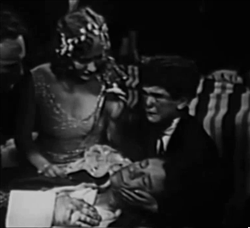


The Circus Kid (1928)
#the circus kid 1928#frankie darro#10 year old darro#joe e brown#helene costello#lionel belmore#sam nelson#darro in silent era
13 notes
·
View notes
Photo



Run, Girl, Run (1928) Alfred J. Goulding
September 28th 2022
#run girl run#1928#alfred j. goulding#carole lombard#daphne pollard#lionel belmore#jim hallett#mack sennett#short
3 notes
·
View notes
Photo








Lionel Belmore in the 1920s
Actors of the 1920s. The 1920s was the last decade before talkies arrived in 1929. Many theater actors were not impressed with silent movies and waited until sound to start their careers in movies.
Lionel Belmore is one of those actor to take advantage of the opportunities that silent movies provided. Many of the feature films have been lost. Some in a fire, other through deterioration. Photos #5 and #6 are from an early talkie 1929s “TheLove Parade” featuring Maurice Chevalier in a singing role. And that is svelte Eugene Pallette in pic #5.
8 notes
·
View notes
Text
6.27.19

#film#letterboxd#watched#design for living#ernst lubitsch#fredric march#gary cooper#miriam hopkins#edward everett horton#vernon steele#rolfe sedan#franklin pangborn#lionel belmore
19 notes
·
View notes
Text










Frankenstein (1931)
"And you really believe that you can bring life to the dead?"
"That body is not dead; it has never lived. I created it - I made it with my own hands, from the bodies I took from graves, from the gallows, anywhere!"
#frankenstein#1931#universal monster cycle#horror film#james whale#films i done watched#boris karloff#colin clive#mae clarke#john boles#edward van sloan#frederick kerr#dwight frye#lionel belmore#marilyn harris#francis ford#mary shelley#novel adaptation#guess who splurged on a frankenstein boxset? this idiot that's who. time to watch the universal frankenstein cycle start to finish#so we begin naturally enough at the beginning. a classic. one of whale's best films and a high achievement for universal in general#after the success of dracula turned the studios fortunes around they greenlit a frankenstein film starring lugosi as the monster. whether h#left or was pushed out (there's some disagreement) lugosi walked and karloff got the part and instantly became a part of pop culture legend#a lot of criticism of the film highlights karloffs excellent performance and rightly so. he brings incredible pathos to the role#despite having no lines and being restricted by heavy make up. but there's a lot more to enjoy here too. colin clive is wonderful as#frankenstein. sure the 'it's alive' scene is a bit hammy but in other scenes of quiet desperation and mental instability he's utterly#brilliant. dwight fryes fritz looks like he's walked straight off the set of a german expressionist film and is wonderfully creepy through#his brief screentime. the whole look of the film is incredible with it's avant garde castle interiors and that amazing laboratory set#and some of this must have been shocking at the time. i mean this film is almost 90 years old but the scene of little maria being carried#dead through the wedding party is still chilling. as for the actual killing of maria it was so controversial that it was removed from the#negative and lost until the 80s. there's a considerable drop in picture quality for that scene which is understandable. otherwise this blu
9 notes
·
View notes
Text
The Epic Eye-Brows of Lionel Belmore
The Epic Eye-Brows of Lionel Belmore
The visage of Lionel Belmore (1867-1953) is one you have surely seen in supporting roles in dozens of classic Hollywood films. Today we are apt to associate him with horror, although that was far from the only genre in which the theatrical veteran toiled. For quick reference, he was the pettifogging Burgomaster in Frankenstein (1931), and the similarly titled Burgermeister in The Vampire Bat…

View On WordPress
0 notes
Photo


Motion Picture News, 1 February 1930
First things first: I’ve got nothing against Tibbett nor anyone who finds him hot/handsome/whatever. Reviewer too is of course free to say what they like. But trying to judge as objectively as possible, I just can’t understand this “for women” approach. He’s not all that conventionally attractive, is he? Or maybe I’m only saying so because he didn’t become women’s favourite. Hindsight. Or maybe it’s the angry eyebrows. Anyways, less praise would’ve been more realistic, I think.
The comment about Laurel and Hardy sounds reasonable, especially since their involvement was an afterthought. As for those character names, all I can discern on the soundtrack is that one time during their final scene when Murza-Bek calls himself Oliver. 😁
One of the more interesting names on the cast list is Kate Price, flanked by Tibbett and Belmore in the photo above. She’d been in movies since 1910 and made ten or so (depending on what source you believe) one-reelers with Oliver Hardy in 1916. At least one of them survives, though I can’t find A Warm Reception anywhere. Their paths crossed again when they played mother and son in Larry Semon’s feature The Perfect Clown (1925), which is on YouTube.
#Stan Laurel#Oliver Hardy#Lawrence Tibbett#Kate Price#Lionel Belmore#Laurel and Hardy#The Rogue Song#1930#1930s#features#movies#Babe's solo work
17 notes
·
View notes
Text










Monte Carlo (Ernst Lubitsch, 1930)
Cast: Jack Buchanan, Jeanette MacDonald, Claud Allister, Zasu Pitts, Tyler Brooke, John Roache, Lionel Belmore, Albert Conti, Helen Garden, Donald Novis, Erik Bey, David Percy. Screenplay: Ernest Vajda, based on a novel by Booth Tarkington and a play by Hans Müller and Evelyn Greenleaf Sutherland. Cinematography: Victor Milner. Costumes: Travis Banton. Film editing: Merrill G. White. Music: Karl Hajos, Herman Hand, W. Franke Harling, Sigmund Krumgold, John Leipold.
0 notes
Photo


Movies I saw in 2017
↳ Frankenstein (1931)
#Frankenstein#*2017#Boris Karloff#Colin Clive#Dwight Frye#Mae Clarke#Edward Van Sloan#John Boles#Fredrick Kerr#Lionel Belmore
49 notes
·
View notes
Text

Grace Darmond (born Grace Marie Glionna; November 20, 1893 – October 8, 1963) was a Canadian-American actress.
Grace Marie Glionna was born in Toronto on November 20, 1893. Her parents were Vincent Glionna, an American-born violinist who had lived in Canada since 1877, and Alice Louise Sparks Glionna (1873–1963), an Ontario native.[4] She was of Italian descent on her father's side.
When Glionna was 16, Vincent Glionna died, and she and her mother immigrated to the United States, settling in Chicago.
As a teenager, Grace Glionna began to appear on the stage, changing her name to Grace Darmond. She signed with Selig Polyscope Company in 1914, and made her film debut in the comedy short The Clock Went Wrong.
Darmond was active onscreen from 1914 to 1927. She starred in the first Technicolor film, The Gulf Between (1917), with actor Niles Welch. The film premiered September 13 in Boston and September 21 at the Aeolian Hall in New York City. However, when the film went into limited release in early 1918 on a tour of Eastern U. S. cities, it was a critical and commercial failure. The early Technicolor process ("System 1") was an additive color process that required a special projector, and it suffered from "fringing" and "haloing" of colors.
Darmond was pretty, slender, and starred in many notable films of the period, but she never was able to break through as a leading actress in big budget films. Most of her roles were in support of bigger names of the time, and most of her starring roles were smaller, lesser known films. She appeared in Below the Surface (1920), in which she starred with Hobart Bosworth and Lloyd Hughes, and that same year she played in A Dangerous Adventure, produced and directed by Warner Brothers.[8] This led to her being cast alongside Boris Karloff in the mystery thriller The Hope Diamond Mystery (1921). In the July edition of Motion Picture Magazine, she was featured in an article by Joan Tully entitled "Mantled With Shyness (A Word Portrait of Grace Darmond)".
Her last most notable film was Wide Open (1927), starring Lionel Belmore and Dick Grace. When the advent of talkies came about, Darmond, like so many actresses and actors from the silent film era, was not able to make a successful transition. She ended her acting career, and for the most part disappeared from the public eye until her death in 1963.
Darmond was a lesbian. Although performing in a substantial number of films over roughly 13 years, she was known in Hollywood's inner circle as the lover of actress Jean Acker, the first wife of actor Rudolph Valentino. She was also associated, as many struggling actresses of the day were, with the actress Alla Nazimova, a former lover of Acker, although it has never been verified that Nazimova and Darmond were ever linked romantically. She and Acker attended parties at Nazimova's Garden of Allah, an imposing house on Sunset Boulevard named punningly after a Robert Smythe Hichens play Nazimova had appeared in.
She and Jean Acker met in 1918, and the two became lovers shortly thereafter. Acker met relatively unknown actor Valentino only a few months later at a party at Nazimova's home. She and Valentino began dating, but reportedly never had sexual relations. They married in 1919, but on their wedding night, Acker fled the house and ran to Darmond's home, stating that it was her that she loved. The marriage is alleged to have never been consummated, and Acker filed for a legal separation in 1921; she later filed charges of bigamy against Valentino when he married designer Natacha Rambova in Mexico before his divorce from Acker was finalized.
Darmond married Randolph P. Jennings, an oil man, on January 22, 1928. The marriage was solemnized in Hollywood by a minister called James H. Lash, and witnessed by Lillian Willat (legal married name of actress Billie Dove) and Robert Fairbanks (possibly Robert Payne Ullman, who was known professionally as Robert Fairbanks, brother of the actor Douglas Elton Thomas Ullman, aka Douglas Fairbanks).[16] This probable venue of the wedding was 7065 Hollywood Boulevard, which was the site of the Hollywood Congregational Church in the 1920s.
Darmond evidently lied about her age to her fiancé as well as the county clerk, as she would have been at least 29 at the time the marriage license was issued. There is an issue about whether she was born November 20, 1893, or November 20, 1898, but she could not possibly have been born as late as 1901.[18] She clearly continued this subterfuge with her husband into their marriage, as she is listed as his wife, Grace D. Jennings, 28, on the 1930 census, which also reveals that the couple resided at 712 N. Beverly Drive, Beverly Hills, California, and that they had a butler called Chris W. Tandoc. The pair divorced in 1935.
Darmond died at the age of 69 in her apartment at 7850 W. Sunset Blvd. (formerly the San Ramon Apartments; currently known as The Villa Rosa) in Hollywood. At the time, she had been being treated for lung pain at the Motion Picture & Television Country Hospital in Woodland Hills, Los Angeles.
6 notes
·
View notes
Text
The Vampire Bat
The Vampire Bat (1933) starring Lionel Atwill, Fay Wray, Melvyn Douglas, Dwight Frye, Robert Frazer
The Vampire Bat (1933) starring Lionel Atwill, Fay Wray, Melvyn Douglas, Dwight Frye, Robert Frazer Synopsis of The Vampire Bat Fay Wray, Melvyn Douglas, and Lionel Atwill in The Vampire Bat
In The Vampire Bat, people are dying in the small German town of Kleinschloss. They are found dead in bed and drained of blood. So, Burgermeister Gustave Schoen (Lionel Belmore) and Dr Otto von…
View On WordPress
#1933#Dwight Frye#Fay Wray#Lionel Atwill#Lionel Belmore#mad scientist#Melvyn Douglas#Robert Frazer#Stella Adams#vampire
0 notes
Photo






Frankenstein (1931) James Whale
July 3rd 2020
#frankenstein#1931#james whale#colin clive#mae clarke#boris karloff#john boles#edward van sloan#dwight frye#frederick kerr#lionel belmore#marilyn harris#pre-code
15 notes
·
View notes